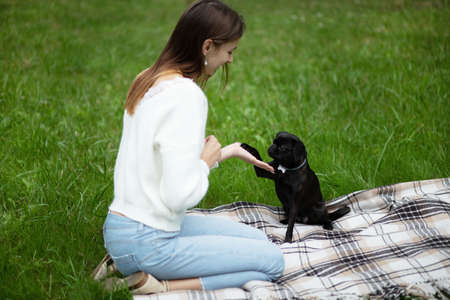1. Indoor Obstacle Courses
Creating an indoor obstacle course is a great way to keep your small pet active while also engaging their mind. These courses can be customized to suit different types of pets, such as rabbits, guinea pigs, ferrets, or even hamsters.
How to Set Up an Indoor Obstacle Course
You don’t need expensive equipment to build a fun and safe obstacle course for your pet. You can use household items to create tunnels, ramps, and small hurdles. Here’s a simple guide:
| Obstacle Type | Materials Needed |
|---|---|
| Tunnels | Cardboard boxes, PVC pipes, or fabric tunnels |
| Ramps | Small wooden planks, sturdy books, or pet-safe platforms |
| Hurdles | Popsicle sticks, small rods, or soft objects like pillows |
Tips for a Safe and Engaging Course
- Ensure Stability: Make sure all obstacles are secure and won’t tip over easily.
- Avoid Sharp Edges: Use materials that are smooth and safe for your pet.
- Add Treats for Motivation: Place small treats along the course to encourage participation.
- Supervise at All Times: Always watch your pet to prevent accidents or stress.
The Benefits of an Obstacle Course
An obstacle course provides both physical exercise and mental stimulation for small pets. It helps improve coordination, builds confidence, and prevents boredom. Regular playtime with these courses can contribute to your pet’s overall health and happiness.
2. Interactive Toy Play
Interactive toys are a fantastic way to keep your small pet active while also stimulating their mind. These toys encourage movement, problem-solving, and engagement, making playtime both fun and beneficial for their overall well-being.
Benefits of Interactive Toys
- Physical Exercise: Encourages running, jumping, and pawing to access treats or rewards.
- Mental Stimulation: Helps prevent boredom and destructive behaviors by challenging their thinking.
- Bonding Opportunity: Allows you to interact with your pet and strengthen your relationship.
Types of Interactive Toys
| Toy Type | Description | Best For |
|---|---|---|
| Treat-Dispensing Balls | Your pet must roll or nudge the ball to release treats. | Rabbits, guinea pigs, ferrets |
| Puzzle Toys | A toy with hidden compartments that require solving to access treats. | Rats, hamsters, rabbits |
| Tunnel Systems | A series of tunnels where pets can hide and explore. | Guinea pigs, ferrets, hamsters |
| Squeaky or Motion Toys | Toys that move or make noise when touched to spark curiosity. | Mice, rats, ferrets |
Tips for Safe Playtime with Interactive Toys
- Select Pet-Safe Materials: Choose non-toxic and chew-resistant materials to prevent accidental ingestion.
- Avoid Small or Loose Parts: Ensure the toy doesnt have detachable pieces that could be swallowed.
- Cater to Your Pet’s Size: Pick toys appropriate for your pet’s size and activity level.
- Supervise Playtime: Always monitor your pet while they interact with new toys to ensure safety.
- Clean Regularly: Wash toys frequently to prevent bacteria buildup and keep them hygienic.
Create Your Own DIY Interactive Toys!
If youre looking for a budget-friendly option, consider making DIY interactive toys using household items. Simple ideas include stuffing a toilet paper roll with hay for rabbits or creating a treat puzzle by cutting holes in a small cardboard box. Just make sure all materials used are safe for your pet!
Interactive toy play is an excellent way to keep your small pet engaged while promoting exercise and mental stimulation. By incorporating different types of toys into their routine, you can help them stay happy, healthy, and entertained!
![]()
3. Supervised Outdoor Exploration
Taking your small pet outside can be a great way to provide them with new experiences, fresh air, and mental stimulation. However, it’s important to do so in a safe and controlled manner. Whether you use a secure enclosure or a harness and leash, outdoor time can be both fun and enriching for your furry friend.
Benefits of Outdoor Exploration
- Mental Stimulation: New sights, smells, and textures keep your pet engaged.
- Physical Exercise: Walking, hopping, or scurrying around helps maintain a healthy weight.
- Enrichment: Exposure to nature enhances their overall well-being.
Ways to Safely Explore Outdoors
| Method | Description |
|---|---|
| Secure Playpen | A portable enclosure allows your pet to enjoy the outdoors without the risk of escape. |
| Harness and Leash | A properly fitted harness lets you guide your pet while keeping them safe from dangers. |
| Backyard Exploration | If you have a fenced yard, monitor your pet closely as they explore. |
Tips for a Safe Outdoor Experience
- Choose a Quiet Area: Avoid loud noises or crowded places that could stress your pet.
- Avoid Extreme Weather: Too hot or too cold conditions can be harmful.
- Watch for Predators: Keep an eye out for birds, cats, or other potential threats.
- Stay Close: Never leave your pet unattended during outdoor time.
A little supervised outdoor exploration can go a long way in keeping your small pet happy and active. With the right precautions, you can create a safe and exciting adventure that benefits both their body and mind!
4. Hide and Seek Games
Engaging your small pet in hide and seek games is a fantastic way to encourage both physical movement and mental stimulation. This activity taps into their natural foraging instincts, making it an enjoyable and enriching experience.
How to Play Hide and Seek with Your Pet
Setting up a hide and seek game is simple and can be customized based on your pet’s preferences. Follow these steps to create a fun challenge:
- Choose a Safe Play Area: Ensure the space is free of hazards where your pet can safely explore.
- Use Treats or Favorite Toys: Hide small treats or beloved toys in various spots around their play area.
- Encourage Exploration: Guide them to start searching by pointing to the first hiding spot or using verbal cues.
- Reward Success: Praise and reward them when they find the hidden items to reinforce the behavior.
Best Hiding Spots for Small Pets
Different pets enjoy different types of challenges, so try varying the locations where you hide treats or toys:
| Pet Type | Recommended Hiding Spots |
|---|---|
| Rabbits | Inside tunnels, under hay piles, behind soft bedding |
| Guinea Pigs | In cozy hideouts, under small blankets, near food bowls |
| Hamsters | Within their digging substrate, inside exercise tubes, under chew toys |
| Ferrets | Inside fabric pouches, under cushions, in cardboard boxes |
Tips for a Fun and Safe Game
- Avoid Unsafe Objects: Only use pet-safe treats and toys that wont pose choking hazards.
- Rotate Hiding Spots: Change locations frequently to keep the game interesting.
- Monitor Playtime: Supervise your pet to ensure they don’t get stuck or frustrated.
- Make It Gradually Harder: Start with easy hiding spots and increase difficulty as they get better at finding items.
This game not only provides exercise but also enhances problem-solving skills, making it an excellent addition to your small pets daily routine.
5. Running Wheel or Tunnel Fun
Providing your small pet with a safe exercise wheel or play tunnel is a great way to encourage their natural running and burrowing behaviors. Many small pets, such as hamsters, mice, and gerbils, love to run for miles on an exercise wheel, while rabbits and guinea pigs enjoy exploring tunnels. These activities help keep your pet active and mentally stimulated.
Choosing the Right Exercise Wheel
Not all exercise wheels are created equal. Choosing the right one ensures safety and comfort for your pet. Here are some key factors to consider:
| Feature | Why It Matters |
|---|---|
| Solid Running Surface | Prevents injury by avoiding gaps that can trap tiny feet or tails. |
| Proper Size | Avoids back strain by ensuring your pet’s spine stays straight while running. |
| Quiet Operation | Keeps noise levels down, especially important for nighttime runners like hamsters. |
| Sturdy Build | Makes sure the wheel doesn’t tip over or break easily. |
The Benefits of Play Tunnels
Tunnels are another excellent way to engage your small pet in healthy exercise. Many animals naturally burrow in the wild, and tunnels mimic this environment, giving them a sense of security while encouraging movement.
Tunnel Types to Consider:
- Collapsible Fabric Tunnels: Great for rabbits and guinea pigs; easy to store when not in use.
- PVC or Plastic Tubes: Durable and suitable for hamsters, rats, and ferrets.
- Nesting Tunnels: Made from hay or cardboard, these provide both shelter and a fun chewing option.
Tips for Safe and Fun Use
- Select the right size: Ensure the wheel or tunnel is appropriate for your pet’s species and size.
- Avoid wire wheels: Solid-surface wheels prevent injuries to tiny paws and tails.
- Add variety: Combine tunnels with other toys to keep things interesting for your pet.
- Cleansing routine: Regularly clean tunnels and wheels to maintain hygiene and prevent odors.
An exercise wheel or play tunnel can make a huge difference in keeping your small pet happy and healthy. By choosing safe, well-designed options, you’ll provide them with endless hours of fun while promoting natural behaviors!


